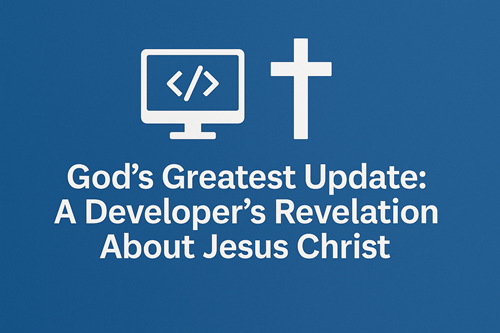By Christina Grant
After 64 years of living, believing, and questioning, I’ve come to a realization that feels like a personal revelation—one that weaves together my faith, life experience, and the very human question: Why did God send His only Son to be born of a virgin, to live, to die, and to rise again—for us?
I’ve been a practicing Catholic for most of my life. I’ve studied religion, sat through countless masses, and even explored faiths beyond my own—from the Torah to the Quran, to ancient Druidic texts. I’ve prayed in freedom, and I’ve prayed in faith. And in all that time, I still found myself asking the same question: Why Jesus? Why the cross? Why was this necessary for us to return to God?
And then it struck me.
We know from Scripture that God created us in His image.
“God created mankind in his image; in the image of God he created them...” (Genesis 1:27, NABRE)
But somewhere along the way, we sinned. We were cast out—not just of Eden, but from complete communion with Him. We were left to toil, to wander, to wonder.
But here’s what I believe now: in creating us, something was still missing from the design—not because God is imperfect, but because we were made for something more.
Before creation, God was one. Alone. All-knowing, all-powerful—but without anything to love. Love requires relationship. It requires another. And when He made us, we were meant to reflect that capacity to love—but we didn’t understand it. We chose pride, disobedience, and fear. The image of God in us became fractured.
So, He came to fix it. Not with fire or thunder—but with flesh.
Jesus Christ, born of a virgin, lived among us to teach us what we never understood on our own: love. Not just affection or duty, but the radical, self-giving love that forgives, that heals, that sacrifices. And in doing so, Jesus didn’t just save us—He completed the plan.
We often think of salvation as a rescue mission. But maybe it was more than that. Maybe Jesus came to reveal something that was never fully known: that love is not just what God gives, but what He is. Jesus showed us this in every word, every miracle, every moment on the cross. He didn’t just die for us—He died with love for us, so we could see it, feel it, and be transformed by it.
And here’s something else I’ve come to believe, especially as someone who works with technology, coding, and creation: when you create something—even a simple program—it’s never perfect the first time. You iterate, debug, refine. You learn as you build. Could it be that God, in creating us, allowed space for love to unfold not through force, but through freedom? Through Christ?
For billions of years, the earth evolved. Dinosaurs roamed. Nature grew. Humanity didn’t arrive until relatively recently. And even then, our growth was slow—thousands of years to learn how to write, hundreds to reach the Industrial Age. Then, suddenly, in just the past few decades, we’ve advanced faster than ever. In less than 20 years, we’ve gone from simple web pages to artificial intelligence and space travel.
It feels like a kind of spiritual metaphor: we were evolving, and then boom—the light of Christ entered the story. Through Jesus, love became the code that upgraded us.
I don’t claim this as theological fact. I would never presume to tell God what He did or why. This understanding strengthened my faith and I do know that this reflection has changed me. It’s helped me see the Gospel not as a story about punishment and redemption, but about relationship and repair. God created us in His image, yes—but in Jesus, He completed that image with love.
Because in the end, we’re all part of His divine creation. And like any creation, we need maintenance. We need guidance. We need… updates. And Jesus was the update we needed most—not just to fix what was broken, but to teach us how to live as love.
So, I end with this:
We are God’s children, crafted by the greatest Creator of all. But we were never meant to run without love in our core. Jesus gave us that love. He is the code that completes us.
Praise the Lord.

